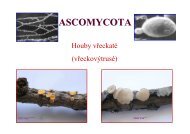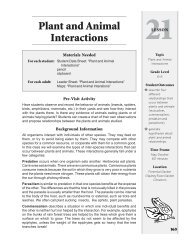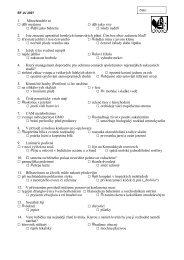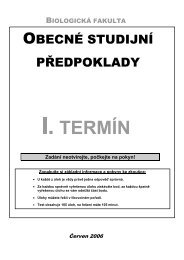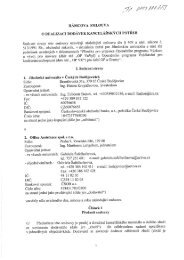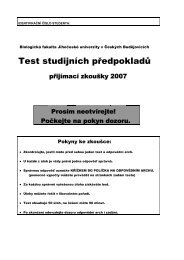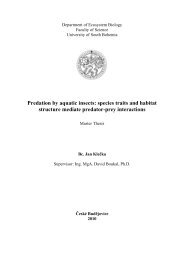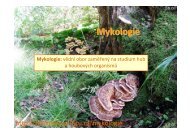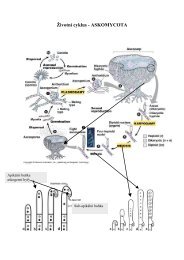The structure and dynamics of a water beetle community in a ...
The structure and dynamics of a water beetle community in a ...
The structure and dynamics of a water beetle community in a ...
You also want an ePaper? Increase the reach of your titles
YUMPU automatically turns print PDFs into web optimized ePapers that Google loves.
were focused on daily flight periodicity, thus the upper <strong>and</strong> lower thresholds may arise from<br />
the fact that the flight was observed to be most <strong>in</strong>tense around sunset <strong>and</strong> sunrise. Accord<strong>in</strong>g<br />
to Csabai et al (2006), this daily flight pattern is caused by changes <strong>in</strong> polarotactical<br />
detectability <strong>of</strong> <strong>water</strong> bodies <strong>and</strong> not by temperature. <strong>The</strong> existence <strong>of</strong> lower temperature<br />
threshold is plausible, but the upper threshold may simply arise from the fact that none or<br />
very low flight activity was observed around noon. However, <strong>in</strong> several species <strong>of</strong> <strong>in</strong>sects,<br />
Taylor (1963) found an upper threshold even when the data were restricted to those parts <strong>of</strong><br />
the day when flight occurs. In <strong>water</strong> <strong>beetle</strong>s, the upper temperature threshold may occur at<br />
higher temperatures than were available <strong>in</strong> my case.<br />
<strong>The</strong> Scirtidae have terrestrial adults but aquatic larvae <strong>and</strong> thus desiccation means loss<br />
<strong>of</strong> habitat for oviposition <strong>and</strong> larval development. I therefore expected to f<strong>in</strong>d some effect <strong>of</strong><br />
<strong>water</strong> depth on their flight activity. Although they show a very similar pattern <strong>of</strong> temperature<br />
dependence <strong>in</strong> flight activity as the Dytiscidae <strong>and</strong> Hydrophilidae, I could not detect any<br />
<strong>in</strong>fluence by <strong>water</strong> depth.<br />
<strong>The</strong> seasonal differences <strong>in</strong> the relative species composition <strong>in</strong> light trap samples are<br />
likely to come from differences <strong>in</strong> life-histories (e.g. the dom<strong>in</strong>ance <strong>of</strong> the Scirtidae <strong>in</strong> spr<strong>in</strong>g,<br />
which may represent the pre-breed<strong>in</strong>g dispersal) <strong>and</strong> different responses to desiccation (clear<br />
dom<strong>in</strong>ance <strong>of</strong> the Hydrophiloidea <strong>in</strong> mid-summer). <strong>The</strong> responses to temperature <strong>and</strong> <strong>water</strong><br />
depth seem to be species specific <strong>and</strong> may also be a result <strong>of</strong> differences <strong>in</strong> life histories.<br />
Moreover, as mentioned above, different species may have different temperature thresholds<br />
because <strong>of</strong> physiological constra<strong>in</strong>ts. <strong>The</strong> lack <strong>of</strong> a significant result <strong>in</strong> CCA <strong>in</strong> the Scirtidae<br />
may simply come from a low taxonomical <strong>and</strong> ecological diversity – the family is represented<br />
<strong>in</strong> my data only by six species <strong>of</strong> Cyphon <strong>and</strong> Microcara testacea. <strong>The</strong> Dytiscidae <strong>and</strong><br />
Hydrophiloidea <strong>in</strong> the light trap samples are much more diverse taxonomically as well as<br />
ecologically.<br />
Females <strong>of</strong> the div<strong>in</strong>g seem to disperse more than males, although I also cannot<br />
completely rule out methodological artefacts (e.g. sex-specific attractivity <strong>of</strong> the light trap). A<br />
possible explanation <strong>of</strong> this phenomenon is that females are more sensitive to habitat<br />
degradation because they need to oviposit <strong>in</strong> a safe habitat. <strong>The</strong> female-biased flight may also<br />
be <strong>in</strong>dependent <strong>of</strong> local conditions. Sex-biased dispersal has been observed <strong>in</strong> birds <strong>and</strong><br />
mammals, where it is assumed to decrease <strong>in</strong>trasexual competition <strong>and</strong> avoid <strong>in</strong>breed<strong>in</strong>g (e.g.<br />
Greenwood 1980). In <strong>in</strong>sect, sex-biased dispersal is well known e.g. <strong>in</strong> social Hymenoptera<br />
(e.g. Kukuk et al. 2005). No thorough exam<strong>in</strong>ation <strong>of</strong> this topic has been carried out <strong>in</strong> <strong>water</strong><br />
<strong>beetle</strong>s <strong>and</strong> most other aquatic <strong>in</strong>sects so far.<br />
36



